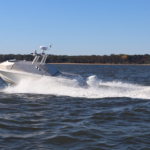
A new report from the Congressional Research Service (CRS) outlines the changes made to the new Constellation-class (FFG-62) frigate from its parent design. The Navy awarded Fincantieri’s Marinette Marine a $795 million contract in 2020 for the detail design and construction of the first frigate, with options for the following nine ships. The Navy plans to procure upward of 20 total (Defense Daily, April 30, 2020). The original frigate competition required contractors to use parent designs to speed up the…

 By
By 










